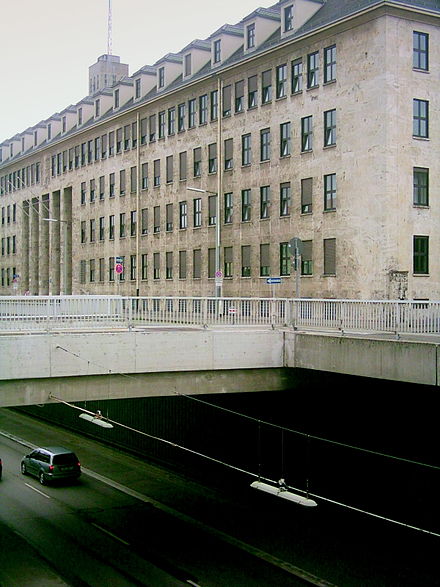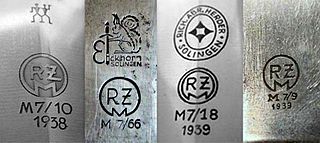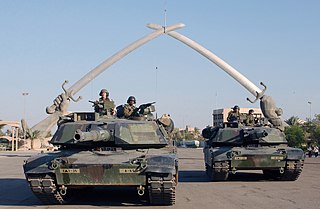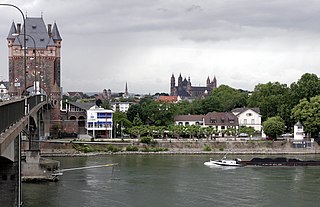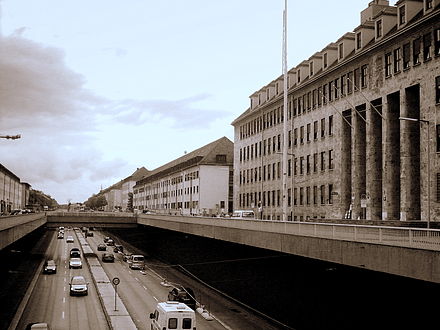
Obergiesing is a borough of Munich, about 3 miles south-east of the city center. The larger part is residential or a mix of business and residential, but there are also a number of recreational facilities.
Kaiserslautern Military Community is a community of Americans living in and around Kaiserslautern, Germany, supporting United States Armed Forces and NATO installations, such as the Ramstein Air Base, Landstuhl Regional Medical Center, Kapaun Air Station, Vogelweh Housing Area, Pulaski Barracks, Kleber Kaserne, Daenner Kaserne, Panzer Kaserne, Sembach Kaserne, Miesau Army Depot, and Rhine Ordnance Barracks. With around 54,000 people, including military service members, Department of Defense civilians and contractors as well as their families, the KMC is the largest U.S. military community outside of the United States.

Tegernsee is a town in the Miesbach district of Bavaria, Germany, on the shore of Lake Tegernsee 747 m (2,451 ft) above sea level.

Franz Xaver Ritter von Epp, from 1916 Ritter von Epp, was a German general and politician who started his military career in the Bavarian Army. Successful wartime military service earned him a knighthood in 1916. After the end of World War I and the dissolution of the German Empire, von Epp was a commanding officer in the Freikorps and the Reichswehr. He was a member of Bavarian People's Party, before joining the Nazi Party in 1928, when he was elected as a member of the German parliament or Reichstag, a position he held until the fall of Nazi Germany. He was the Reichskommissar, later Reichsstatthalter, for Bavaria.

The Bavarian State Police is the official State police force of the German State of Bavaria. It has approximately 33,500 armed officers and roughly 8,500 other civilian employees. The Bavarian police is well-known for the coordinated and consistent actions against even minor crimes.
Francis Xavier McGraw was a United States Army soldier and a recipient of the United States military's highest decoration, the Medal of Honor, for his actions during the Battle of Hurtgen Forest in World War II.

Gau Swabia was an administrative division of Nazi Germany in Swabia, Bavaria, from 1933 to 1945. From 1926 to 1933, it was the regional subdivision of the Nazi Party in that area.

The Gau Munich–Upper Bavaria was an administrative division of Nazi Germany in Upper Bavaria from 1933 to 1945. From 1926 to 1933, it was the regional subdivision of the Nazi Party in that area.

Robert Vorhoelzer was a German architect.

The Maximilian-II-Kaserne respectively Max-II-Kaserne was a military facility in Munich, Germany, which was completed in 1865. The kaserne was named after Maximilian II of Bavaria.

The Ernst-von-Bergmann-Kaserne, before called Warner Kaserne by the US Army (1950-1968), has been a military facility in Munich, Germany, which was built by the architect Oswald Bieber between 1934 and 1936. The current name was given in honor of professor Ernst von Bergmann.
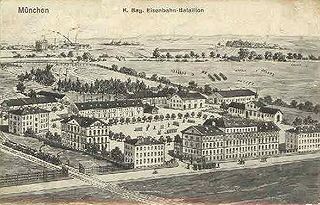
The Eisenbahnkaserne was a military barracks in Munich that existed from 1890 to 1976. The "Kasernement des Eisenbahnbataillons" was built in 1888 and 1889. It was located west of today's Olympiapark on Dachauer Straße, where the Bundeswehr Administration Centre is now located.
Fürst-Wrede-Kaserne has been a military facility in Munich, Germany, since 1936 when it was built by the Munich Heeresbauamt under its original name Verdun-Kaserne. After World War II the U.S. forces renamed it Will Kaserne, and the Bundeswehr renamed it once more in honor of Karl Philipp von Wrede on April 17, 1972.
The Luitpoldkaserne, originally Luftschifferkaserne, was a kaserne at Infanteriestraße 19 in Munich, Germany, which was built after 1896 to accommodate the air skippers unit of the Bavarian army, which was disposed in 1890.

The Hofgartenkaserne, also known as Infanterie-Leibregiment-Kaserne or Max-Joseph-Kaserne, was a military facility of the Bavarian army, located at Hofgarten Strasse 2 in Munich, Germany. The construction was planned and realized by the war economy councillor Direktorialrat Joseph Frey from 1801 to 1807.
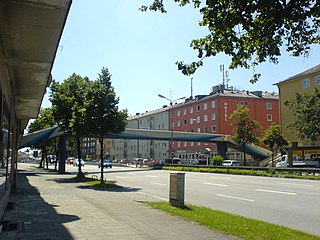
The Tegernseer Landstraße is a street in the Obergiesing borough of Munich, Germany, which runs in a southeastern direction and is a total of 4.6 kilometers long. It begins in the north as a straight extension of the Regerstraße, where it is a regular two-lane road until the Tegernseer Platz. At the Tegernseer Platz, a large branch of the Deutsche Post can be found. The building, nicknamed Tela-Post, was built in 1928 in the architectural style New Objectivity. The Hertie-store, which was located at the Tegernseer Platz until the summer of 2009, was closed because of insolvency and demolished in 2010. Between 1976 and 2016, a branch of the city library was located across the street. There are efforts to strengthen the local economy and prevent vacancy of retail spaces around the Tegernseer Landstraße, which are funded by the federal government.

Ferris Barracks is a former US military garrison located in Erlangen, a Middle Franconian city in Bavaria, Germany. It was active as a US military base between 1945 and 1994. The facility was occupied after World War II and designated Ferris Barracks in honor of Second Lieutenant (2LT) Geoffrey Cheney Ferris. Ferris Barracks was closed on 28 June, 1994, and officially turned over to the German government. Though largely dismantled, certain historic buildings and monuments have been preserved and converted for alternative use. The area has undergone extensive construction and is now referred to as Röthelheimpark.




